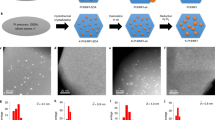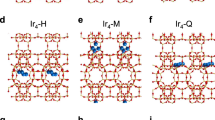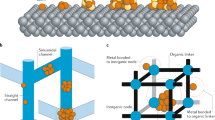Abstract
Modulating the structures of subnanometric metal clusters at the atomic level is a great synthetic and characterization challenge in catalysis. Here, we show how the catalytic properties of subnanometric platinum clusters (0.5–0.6 nm) confined in the sinusoidal 10R channels of purely siliceous MFI zeolite are modulated upon introduction of partially reduced tin species that interact with the noble metal at the metal/support interface. The platinum–tin clusters are stable in H2 over an extended period of time (>6 h), even at high temperatures (for example, 600 °C), which is determined by only a few additional tin atoms added to the platinum clusters. The structural features of platinum–tin clusters, which are not immediately visible by conventional characterization techniques but can be established after combination of in situ extended X-ray absorption fine structure, high-angle annular dark-field scanning transmission electron microscopy and CO infrared data, are key to providing a one-order of magnitude lower deactivation rate in the propane dehydrogenation reaction while maintaining high intrinsic (initial) catalytic activity.

This is a preview of subscription content, access via your institution
Access options
Access Nature and 54 other Nature Portfolio journals
Get Nature+, our best-value online-access subscription
$29.99 / 30 days
cancel any time
Subscribe to this journal
Receive 12 digital issues and online access to articles
$119.00 per year
only $9.92 per issue
Buy this article
- Purchase on Springer Link
- Instant access to full article PDF
Prices may be subject to local taxes which are calculated during checkout







Similar content being viewed by others
Data availability
All the data needed to support the plots and evaluate the conclusions within this article are present within it and the Supplementary Information, or are available from the corresponding author upon reasonable request.
Code availability
The codes used in this work for image analysis are available from the corresponding author upon reasonable request.
References
Liu, L. & Corma, A. Metal catalysts for heterogeneous catalysis: from single atoms to nanoclusters and nanoparticles. Chem. Rev. 118, 4981–5079 (2018).
An, K. & Somorjai, G. A. Nanocatalysis I: synthesis of metal and bimetallic nanoparticles and porous oxides and their catalytic reaction studies. Catal. Lett. 145, 233–248 (2014).
Ferrando, R., Jellinek, J. & Johnston, R. L. Nanoalloys: from theory to applications of alloy clusters and nanoparticles. Chem. Rev. 108, 845–910 (2008).
Yu, W., Porosoff, M. D. & Chen, J. G. Review of Pt-based bimetallic catalysis: from model surfaces to supported catalysts. Chem. Rev. 112, 5780–5817 (2012).
Resasco, D. E. in Encyclopedia of Catalysis (ed. Horváth, I.) (Wiley, 2002).
Vora, B. V. Development of dehydrogenation catalysts and processes. Top. Catal. 55, 1297–1308 (2012).
Sattler, J. J., Ruiz-Martinez, J., Santillan-Jimenez, E. & Weckhuysen, B. M. Catalytic dehydrogenation of light alkanes on metals and metal oxides. Chem. Rev. 114, 10613–10653 (2014).
Sanfilippo, D. & Miracca, I. Dehydrogenation of paraffins: synergies between catalyst design and reactor engineering. Catal. Today 111, 133–139 (2006).
Redekop, E. A. et al. Delivering a modifying element to metal nanoparticles via support: Pt–Ga alloying during the reduction of Pt/Mg(Al,Ga)Ox catalysts and Its effects on propane dehydrogenation. ACS Catal. 4, 1812–1824 (2014).
Deng, L. et al. Dehydrogenation of propane over silica-supported platinum–tin catalysts prepared by direct reduction: effects of tin/platinum ratio and reduction temperature. ChemCatChem 6, 2680–2691 (2014).
Filez, M., Redekop, E. A., Poelman, H., Galvita, V. V. & Marin, G. B. Advanced elemental characterization during Pt–In catalyst formation by wavelet transformed X-ray absorption spectroscopy. Anal. Chem. 87, 3520–3526 (2015).
Searles, K. et al. Highly productive propane dehydrogenation catalyst using silica-supported Ga–Pt nanoparticles generated from single-sites. J. Am. Chem. Soc. 140, 11674–11679 (2018).
Liu, L. et al. Generation of subnanometric platinum with high stability during transformation of a 2D zeolite into 3D. Nat. Mater. 16, 132–138 (2017).
Moliner, M. et al. Reversible transformation of Pt nanoparticles into single atoms inside high-silica chabazite zeolite. J. Am. Chem. Soc. 138, 15743–15750 (2016).
Liu, L. et al. Evolution and stabilization of subnanometric metal species in confined space by in situ TEM. Nat. Commun. 9, 574 (2018).
Liu, Y. et al. A general strategy for fabricating isolated single metal atomic site catalysts in Y zzeolite. J. Am. Chem. Soc. 141, 9305–9311 (2019).
Liu, L. et al. Regioselective generation and reactivity control of subnanometric platinum clusters in zeolites for high-temperature catalysis. Nat. Mater. 18, 866–873 (2019).
Lazic, I., Bosch, E. G. T. & Lazar, S. Phase contrast STEM for thin samples: integrated differential phase contrast. Ultramicroscopy 160, 265–280 (2016).
Yucelen, E., Lazic, I. & Bosch, E. G. T. Phase contrast scanning transmission electron microscopy imaging of light and heavy atoms at the limit of contrast and resolution. Sci. Rep. 8, 2676 (2018).
Lewis, J. D. et al. Distinguishing active site identity in Sn-Beta zeolites using 31P MAS NMR of adsorbed trimethylphosphine oxide. ACS Catal. 8, 3076–3086 (2018).
Uemura, Y. et al. In situ time-resolved XAFS study on the structural transformation and phase separation of Pt3Sn and PtSn alloy nanoparticles on carbon in the oxidation process. Phys. Chem. Chem. Phys. 13, 15833–15844 (2011).
Ramallo-López, J. M. et al. XPS and XAFS Pt L2,3-edge studies of dispersed metallic Pt and PtSn clusters on SiO2 obtained by organometallic synthesis: structural and electronic characteristics. J. Phys. Chem. B 107, 11441–11451 (2003).
Deng, L. et al. Elucidating strong metal-support interactions in Pt–Sn/SiO2 catalyst and its consequences for dehydrogenation of lower alkanes. J. Catal. 365, 277–291 (2018).
Zhang, B. et al. Exceptional electrochemical performance of freestanding electrospun carbon nanofiber anodes containing ultrafine SnOx particles. Energy Environ. Sci. 5, 9895–9902 (2012).
Collins, S. E. et al. The role of Pd–Ga bimetallic particles in the bifunctional mechanism of selective methanol synthesis via CO2 hydrogenation on a Pd/Ga2O3 catalyst. J. Catal. 292, 90–98 (2012).
Ogata, K. et al. Evolving affinity between Coulombic reversibility and hysteretic phase transformations in nano-structured silicon-based lithium-ion batteries. Nat. Commun. 9, 479 (2018).
Cui, C., Gan, L., Heggen, M., Rudi, S. & Strasser, P. Compositional segregation in shaped Pt alloy nanoparticles and their structural behaviour during electrocatalysis. Nat. Mater. 12, 765–771 (2013).
Pei, Y. et al. Catalytic properties of intermetallic platinum-tin nanoparticles with non-stoichiometric compositions. J. Catal. 374, 136–142 (2019).
Freakley, S. J. et al. Palladium-tin catalysts for the direct synthesis of H2O2 with high selectivity. Science 351, 965–968 (2016).
Mayrhofer, K. J., Juhart, V., Hartl, K., Hanzlik, M. & Arenz, M. Adsorbate-induced surface segregation for core–shell nanocatalysts. Angew. Chem. Int. Ed. 48, 3529–3531 (2009).
Peng, L., Ringe, E., Van Duyne, R. P. & Marks, L. D. Segregation in bimetallic nanoparticles. Phys. Chem. Chem. Phys. 17, 27940–27951 (2015).
Li, G.-J., Fujimoto, T., Fukuoka, A. & Ichikawa, M. Ship-in-bottle synthesis of Pt9-Pt15 carbonyl clusters inside NaY and NaX zeolites, in-situ FTIR and EXAFS characterization and the catalytic behaviors in 13CO exchange reaction and NO reduction by CO. Catal. Lett. 12, 171–185 (1992).
Gruene, P., Fielicke, A., Meijer, G. & Rayner, D. M. The adsorption of CO on group 10 (Ni, Pd, Pt) transition-metal clusters. Phys. Chem. Chem. Phys. 10, 6144–6149 (2008).
Serykh, A. I. et al. Stable subnanometre Pt clusters in zeolite NaX via stoichiometric carbonyl complexes: probing of negative charge by DRIFT spectroscopy of adsorbed CO and H2. Phys. Chem. Chem. Phys. 2, 5647–5652 (2000).
Garnier, A., Sall, S., Garin, F., Chetcuti, M. J. & Petit, C. Site effects in the adsorption of carbon monoxide on real 1.8 nm Pt nanoparticles: an infrared investigation in time and temperature. J. Mol. Catal. A 373, 127–134 (2013).
Corma, A., Serna, P., Concepcion, P. & Calvino, J. J. Transforming nonselective into chemoselective metal catalysts for the hydrogenation of substituted nitroaromatics. J. Am. Chem. Soc. 130, 8748–8753 (2008).
Concepcion, P. et al. The promotional effect of Sn-beta zeolites on platinum for the selective hydrogenation of α,β-unsaturated aldehydes. Phys. Chem. Chem. Phys. 15, 12048–12055 (2013).
de Menorval, L.-C., Chaqroune, A., Coq, B. & François Figueras, A. Characterization of mono- and bi-metallic platinum catalysts using CO FTIR spectroscopy size effects and topological segregation. J. Chem. Soc., Faraday Trans. 93, 3715–3720 (1997).
Balakrishnan, K. A chemisorption and XPS study of bimetallic Pt-Sn/Al2O3 catalysts. J. Catal. 127, 287–306 (1991).
Panja, C. & Koel, B. E. Probing the influence of alloyed Sn on Pt(100) surface chemistry by CO chemisorption. Isr. J. Chem. 38, 365–374 (1998).
Liu, Z., Jackson, G. S. & Eichhorn, B. W. PtSn intermetallic, core–shell, and alloy nanoparticles as CO-tolerant electrocatalysts for H2 oxidation. Angew. Chem. Int. Ed. 49, 3173–3176 (2010).
Wang, X. et al. Pt/Sn intermetallic, core/shell and alloy nanoparticles: colloidal synthesis and structural control. Chem. Mater. 25, 1400–1407 (2012).
Redekop, E. A. et al. Early stages in the formation and burning of graphene on a Pt/Mg(Al)Ox dehydrogenation catalyst: a temperature- and time-resolved study. J. Catal. 344, 482–495 (2016).
Shi, L. et al. Al2O3 nanosheets rich in pentacoordinate Al3+ ions stabilize Pt-Sn clusters for propane dehydrogenation. Angew. Chem. Int. Ed. 54, 13994–13998 (2015).
Sattler, J. J., Beale, A. M. & Weckhuysen, B. M. Operando Raman spectroscopy study on the deactivation of Pt/Al2O3 and Pt–Sn/Al2O3 propane dehydrogenation catalysts. Phys. Chem. Chem. Phys. 15, 12095–12103 (2013).
Vu, B. K. et al. Location and structure of coke generated over Pt–Sn/Al2O3 in propane dehydrogenation. J. Ind. Eng. Chem. 17, 71–76 (2011).
Vu, B. K. et al. Pt–Sn alloy phases and coke mobility over Pt–Sn/Al2O3 and Pt–Sn/ZnAl2O4 catalysts for propane dehydrogenation. Appl. Catal. A 400, 25–33 (2011).
Liu, L. et al. Determination of the evolution of heterogeneous single metal atoms and nanoclusters under reaction conditions: which are the working catalytic sites? ACS Catal. 9, 10626–10639 (2019).
López-Haro, M. et al. A macroscopically relevant 3D-metrology approach for nanocatalysis research. Part. Part. Syst. Charact. 35, 1700343 (2018).
Kirkland, E. J. Advanced Computing in Electron Microscopy (Springer, 2010).
Bernal, S. et al. The interpretation of HREM images of supported metal catalysts using image simulation: profile view images. Ultramicroscopy 72, 135–164 (1998).
Simonelli, L. et al. CLÆSS: the hard X-ray absorption beamline of the ALBA CELLS synchrotron. Cogent Phys. 3, 1231987 (2016).
Guilera, G., Rey, F., Hernández-Fenollosa, J. & Cortés-Vergaz, J. J. One body, many heads; the Cerberus of catalysis. A new multipurpose in-situ cell for XAS at ALBA. J. Phys. Conf. Ser. 430, 012057 (2013).
Ravel, B. & Newville, M. ATHENA, ARTEMIS, HEPHAESTUS: data analysis for X-ray absorption spectroscopy using IFEFFIT. J. Synchrotron Radiat. 12, 537–541 (2005).
Yin, F., Ji, S., Wu, P., Zhao, F. & Li, C. Deactivation behavior of Pd-based SBA-15 mesoporous silica catalysts for the catalytic combustion of methane. J. Catal. 257, 108–116 (2008).
Allian, A. D. et al. Chemisorption of CO and mechanism of CO oxidation on supported platinum nanoclusters. J. Am. Chem. Soc. 133, 4498–4517 (2011).
Acknowledgements
This work was supported by the European Union through the European Research Council (grant ERC-AdG-2014-671093, SynCatMatch) and the Spanish government through the “Severo Ochoa Program” (SEV-2016-0683). L.L. thanks the ITQ for providing a contract. The authors also thank the Microscopy Service of the UPV for the TEM and STEM measurements. The XAS measurements were carried out in the CLÆSS beamline of the ALBA synchrotron. We thank Giovanni Agostini for his kind support in the analysis of XAS data. HR-HAADF-STEM measurements were performed at DME-UCA at Cadiz University with financial support from FEDER/MINECO (MAT2017-87579-R and MAT2016-81118-P). C.W.L. thanks CAPES (Science without Frontiers - Process no. 13191/13-6) for a predoctoral fellowship. The financial support from ExxonMobil for this project is also greatly acknowledged.
Author information
Authors and Affiliations
Contributions
A.C. conceived the project, directed the study and wrote the manuscript. L.L. carried out the synthesis, structural characterizations, catalytic measurements and collaborated in writing the manuscript. M.L.-H., R.M. and J.J.C. carried out the quasi in situ HR-HAADF-STEM measurements and image analyses. C.W.L. analysed the XAS data. L.L. and L.S. contributed to the collection of XAS data in the ALBA synchrotron. S.R.-B. carried out the 31P NMR measurements. P.C. carried out the CO-IR adsorption experiments. A.S. and P.S. contributed to the experimental design and data interpretation. All the authors discussed the results and contributed to the formation of the manuscript.
Corresponding author
Ethics declarations
Competing interests
The authors declare no competing interests.
Additional information
Publisher’s note Springer Nature remains neutral with regard to jurisdictional claims in published maps and institutional affiliations.
Supplementary information
Supplementary Information
Supplementary discussion, Figs. 1–73 and Tables 1 and 2.
Rights and permissions
About this article
Cite this article
Liu, L., Lopez-Haro, M., Lopes, C.W. et al. Structural modulation and direct measurement of subnanometric bimetallic PtSn clusters confined in zeolites. Nat Catal 3, 628–638 (2020). https://doi.org/10.1038/s41929-020-0472-7
Received:
Accepted:
Published:
Issue Date:
DOI: https://doi.org/10.1038/s41929-020-0472-7
This article is cited by
-
Pt-modified Fe3O4 Supported on Ni Foam Nanocomposite for Electrocatalytic Nitrate Reduction to Ammonia
Electrocatalysis (2024)
-
Co-aromatization of methane and hexane over Pt encapsulated in ZSM-5 zeolite and the electronic effect of K promoters
Science China Chemistry (2024)
-
Germanium-enriched double-four-membered-ring units inducing zeolite-confined subnanometric Pt clusters for efficient propane dehydrogenation
Nature Catalysis (2023)
-
Structure-dependence and metal-dependence on atomically dispersed Ir catalysts for efficient n-butane dehydrogenation
Nature Communications (2023)
-
Trapped by the germanium ring
Nature Catalysis (2023)



